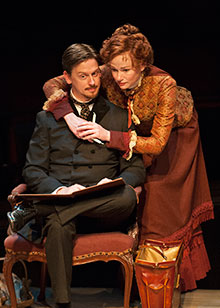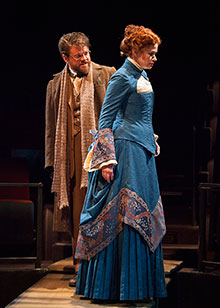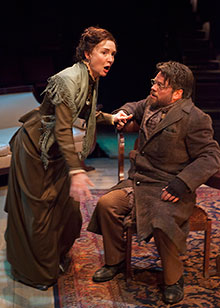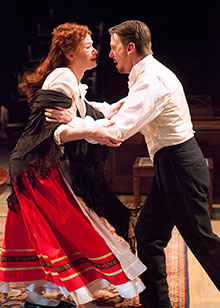
Eight and a half decades before Betty Friedan’s The Feminine Mystique set off what’s known as the Second-Wave Feminist Movement in the U.S., Norwegian playwright Henrik Ibsen created a heroine whose frustration at being “just a housewife” could well have inspired Friedan and her fellow women’s libbers.
Her name, as you may have guessed, was Nora, and if playwright Ibsen steadfastly asserted that he had not consciously “worked for the women’s rights movement,” A Doll’s House must certainly have inspired generation after generation of women in the years since its 1879 debut.
Ibsen’s masterpiece, incidentally the world’s most performed play, now arrives at San Diego’s The Old Globe Theatre in a World Premiere adaptation by translator Anne-Charlotte Hanes Harvey and director Kirsten Brandt that makes Nora, the Norwegians surrounding her, and Ibsen’s play itself seem considerably younger than their one hundred thirty-four years of age.
 Gretchen Hall and Fred Arsenault head the mostly imported-from-New York cast as Nora and Torvald Helmer, a couple whose marriage might have seemed idyllic to the late-19th-Century observer, but one whose cracks contemporary audiences will spot almost as soon as the lights go up.
Gretchen Hall and Fred Arsenault head the mostly imported-from-New York cast as Nora and Torvald Helmer, a couple whose marriage might have seemed idyllic to the late-19th-Century observer, but one whose cracks contemporary audiences will spot almost as soon as the lights go up.
After all, what 21st Century wife would stand for a husband whose litany of pet names (including the oft-spoken “my little songbird,” emphasis on little) make it patently clear exactly who is in charge in this marriage. Then again, a wife more interested in shopping than self-realization would seem a perfect fit for a male chauvinist husband like banker Torvald, set to be pulling in even more money once his New Year’s promotion takes effect.
Nora has a secret, however, one which, if revealed, could upset the delicate balance of her marriage, and worse.
 It turns out that in the early years of their wedded life, Nora was forced to borrow money in order to finance the couple’s one-year sojourn in Italy, without which Torvald would surely have died from ill health. A trifling matter for a contemporary wife, perhaps, but one with potentially dire consequences in a place and time in which a woman had no legal right to borrow without her husband’s knowledge and consent.
It turns out that in the early years of their wedded life, Nora was forced to borrow money in order to finance the couple’s one-year sojourn in Italy, without which Torvald would surely have died from ill health. A trifling matter for a contemporary wife, perhaps, but one with potentially dire consequences in a place and time in which a woman had no legal right to borrow without her husband’s knowledge and consent.
Complicating matters for our heroine are a pair of unexpected arrivals.
First to show up is Kristine Linde (Nisi Sturgis), a longtime friend whom Nora has not seen in a decade, a back-in-town widow with three small children who’s about as down and out as any widow and mother could possibly get. Couldn’t Nora use her wifely charms to get Kristine a job at Torvald’s bank?
 Then there’s Nils Krogstad (Richard Baird), a man whose checkered past (one which includes forgery) may cost him his job at Torvald’s bank unless he can blackmail Nora into convincing her husband to keep him on the payroll. As for Krogstad’s secret weapon, it turns out it was he who lent Nora all those kroner years back, and he’s still got the promissory note to prove it.
Then there’s Nils Krogstad (Richard Baird), a man whose checkered past (one which includes forgery) may cost him his job at Torvald’s bank unless he can blackmail Nora into convincing her husband to keep him on the payroll. As for Krogstad’s secret weapon, it turns out it was he who lent Nora all those kroner years back, and he’s still got the promissory note to prove it.
Completing the cast of dramatis personae is Dr. Rank (Jack Koenig), secretly in love with Nora and secretly dying of “spinal consumption,” 19th Century code for a case of syphilis he inherited from his father.
 If this seems heady stuff for a play written in the late 1870s, it’s no wonder that not only was Ibsen ahead of his time but that A Doll’s House makes for one humdinger of an Old Globe production nearly a century and a half later.
If this seems heady stuff for a play written in the late 1870s, it’s no wonder that not only was Ibsen ahead of his time but that A Doll’s House makes for one humdinger of an Old Globe production nearly a century and a half later.
Brandt directs incisively, making effective use of the Sheryl And Harvey White Theatre’s arena stage, which allows audience members to be flies on all four of the Helmers’
walls.
As Nora, a powerful Hall bears comparison with a young Dianne Wiest, going from flighty to flinty as events force Ibsen’s heroine to discover her own identity and worth. Equally fine is Hall’s real-life spouse Arsenault, who captures Torvald’s aristocratic bearing and condescending attitude towards Nora while never letting go of the character’s humanity. Sturgis, Baird, and Koenig are marvelous too, with Amanda Naughton and Katie Whalley completing the cast in finely rendered cameos as nanny Anne-Marie and housemaid Helene.
 A Doll’s House looks terrific, San Diego’s Sean Fanning giving us a meticulously detailed in-the-round scenic design featuring richly upholstered furniture, spinet piano, and Persian rug, all of this gorgeously lit by David Lee Cuthbert, whose lighting design makes Alina Bokovikova’s elegant period costumes look even more sumptuous. Paul Peterson’s sound design is particularly striking, its crashing ocean waves underlining the inexorability of Ibsen’s characters’ fates.
A Doll’s House looks terrific, San Diego’s Sean Fanning giving us a meticulously detailed in-the-round scenic design featuring richly upholstered furniture, spinet piano, and Persian rug, all of this gorgeously lit by David Lee Cuthbert, whose lighting design makes Alina Bokovikova’s elegant period costumes look even more sumptuous. Paul Peterson’s sound design is particularly striking, its crashing ocean waves underlining the inexorability of Ibsen’s characters’ fates.
Jess Slocum is stage manager, Alex Bezdeka assistant director, and Michelle Hunt Souza assistant costume designer.
The epoch may be historical and the costumes antique, but Henrik Ibsen’s tale of a character morphing from “doll” to self-realized woman remains powerful and relevant to 21st Century audiences, as this all-around topnotch Old Globe production makes abundantly clear.
Old Globe Sheryl and Harvey White Theatre, Balboa Park, San Diego.
www.oldglobe.org
–Steven Stanley
April 6, 2013
Photos: Henry DiRocco


 Since 2007, Steven Stanley's StageSceneLA.com has spotlighted the best in Southern California theater via reviews, interviews, and its annual StageSceneLA Scenies.
Since 2007, Steven Stanley's StageSceneLA.com has spotlighted the best in Southern California theater via reviews, interviews, and its annual StageSceneLA Scenies.







 COPYRIGHT 2025 STEVEN STANLEY :: DESIGN BY
COPYRIGHT 2025 STEVEN STANLEY :: DESIGN BY